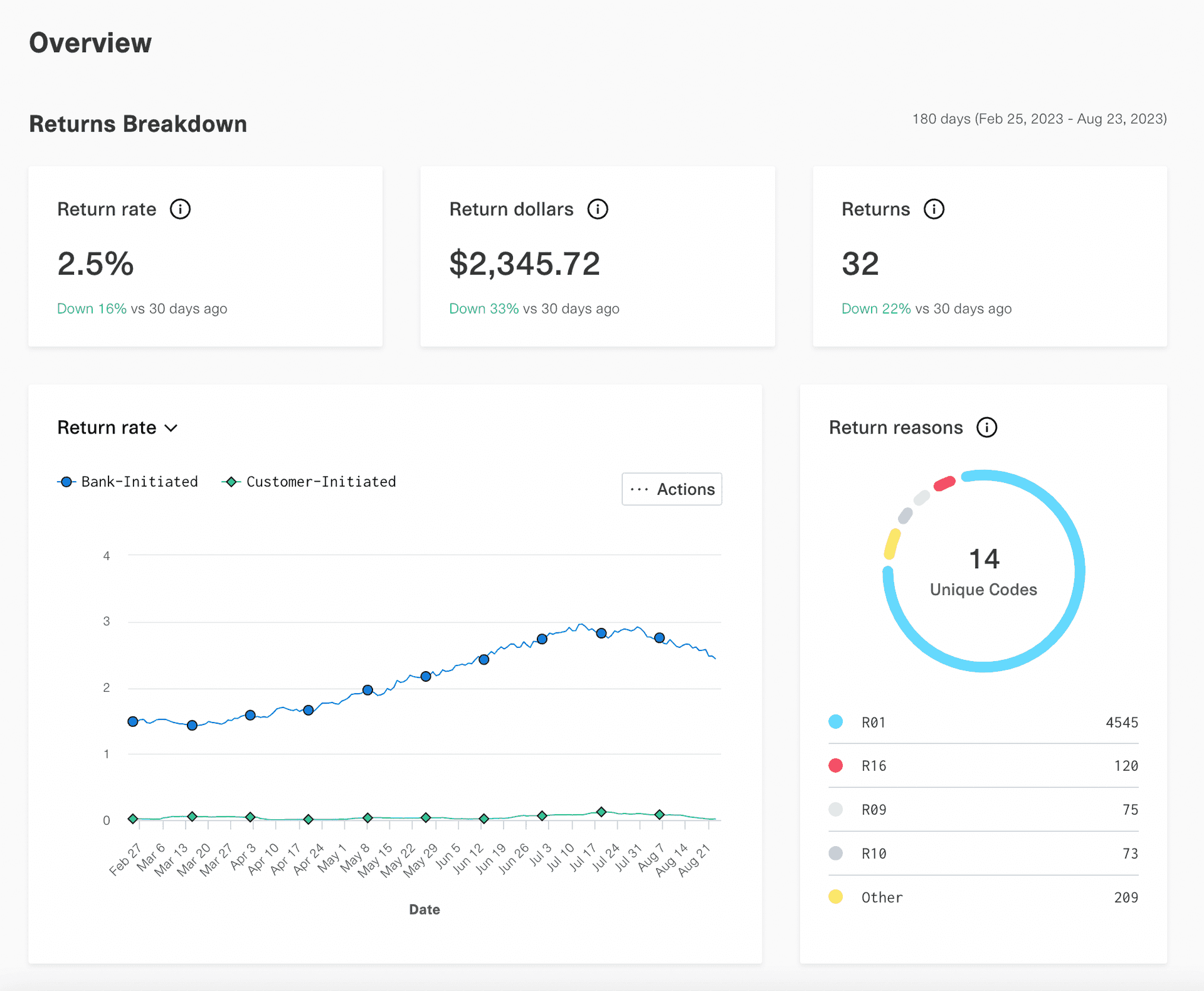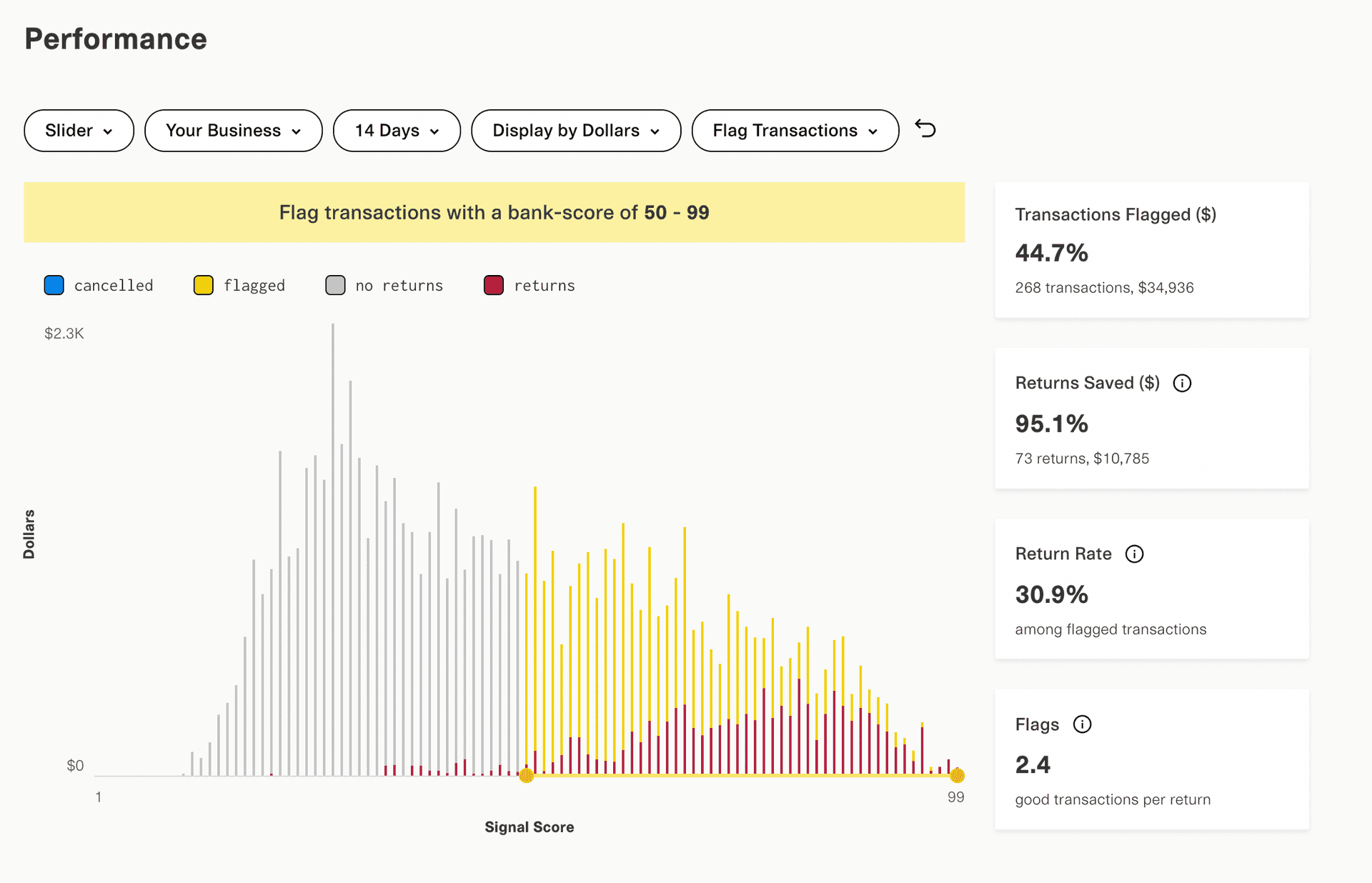Introduction to Signal
Assess the return risk of an ACH debit to prevent NSFs and other returns
API Reference
View Signal requests, responses, and example code
View Signal APIQuickstart
Learn about Plaid's key concepts and run starter code
Get startedOverview
Plaid Signal allows you to evaluate the likelihood of a specific ACH transaction resulting in a return. Signal is powered by a machine learning model trained on Plaid’s consumer-permissioned data network, including over 1,000 risk factors, and is designed to provide a result in under one second. Signal provides two overall risk assessment scores, along with associated risk tiers and over 60 predictive insights that you can incorporate into your own risk assessment models. By using the Signal API, you can release funds earlier to optimize your user experience while managing the risk of ACH returns.
Usage
Signal is intended to be used alongside Auth.
The Signal API consists of three routes and one optional route:
/signal/evaluate: Call this endpoint before initiating an ACH transaction to get the return risk assessment and additional risk signals.
/signal/decision/report: After calling /signal/evaluate, call this endpoint to inform Plaid of your risk and payment decision outcome and whether or not you executed the ACH transaction. Your decision feedback will help the model to optimize for your use case.
/signal/return/report: Call this endpoint when you receive a return for the ACH transaction you previously called the /signal/evaluate endpoint for. Your feedback allows the model to incorporate the latest risk trends into its assessments.
/signal/prepare (optional): Call this endpoint to add Signal to a pre-existing Item that was not initialized with Signal.
Sample flow
- Using
/link/token/create, create a Link token initialized with theauthandsignalproducts, and use this token to launch Link. - The end user completes the Link flow by logging into their financial institution.
- Use
/item/public_token/exchangeto exchange thepublic_tokenreturned from Link'sonSuccesscallback for anaccess_token. - Call
/accounts/getusing theaccess_tokenreturned in the previous step to obtain theaccount_idof the account you will be evaluating. - Call
/signal/evaluateusing theaccess_tokenandaccount_idobtained in the previous steps. - Based on the data returned by
/signal/evaluate, decide whether to proceed directly with the transfer or apply an additional risk mitigation layer. You may either use the risk scoring and tier data returned by/signal/evaluateor use thecore_attributesand feed them into your own model, along with additional information you may have about the user and the proposed transaction. For potentially high-risk transactions, you can also call/accounts/balance/getat this point to obtain real-time balance information and use it as another input into your decision. - If you decide to proceed with the transfer, initiate it as you normally would using Plaid Auth endpoints. For more details, see Auth.
- Report your decision following the risk assessment and whether or not to proceed with the transfer by calling
/signal/decision/report. - If the transfer is later returned, call
/signal/return/report.
Signal data
Signal provides two categories of risk -- customer-initiated return risk, which corresponds to ACH returns initiated by customers (unauthorized ACH returns), and bank-initiated return risk (primarily NSFs and administrative returns), which corresponds to ACH returns initiated by financial institutions. Each risk category has a score ranging from 1-99 and a corresponding risk tier to help you better understand the associated level of return risk.
In addition to the risk scores and tiers, Signal also provides more than 60 predictive insights to help provide even greater visibility into the factors contributing to a given score and tier. You may choose to incorporate these insights into your own risk models.
For more details on the data returned by Signal, see the Signal API reference.
1{2 "scores": {3 "customer_initiated_return_risk": {4 "score": 9,5 "risk_tier": 16 },7 "bank_initiated_return_risk": {8 "score": 72,9 "risk_tier": 710 }11 },12 "core_attributes": {13 "days_since_first_plaid_connection": 510,14 "plaid_connections_count_7d": 6,15 "plaid_connections_count_30d": 7,16 "total_plaid_connections_count": 15,17 "is_savings_or_money_market_account": false,18 ...19 },20 "request_id": "mdqfuVxeoza6mhu"21}Signal Dashboard
To help you monitor your ACH returns and performance, Plaid provides a Signal Dashboard within the Plaid Dashboard. You can access the Signal Dashboard after receiving production access to Signal. On the Dashboard, you can view ACH returns and causes over time, as well as view the details of individual transactions. You can also use the Dashboard to model and backtest the impact of different Signal score risk thresholds on your return rates.


Testing Signal
You can test Signal in the Sandbox and Development environments. In the Sandbox environment, values returned by /signal/evaluate will be randomly generated. Note that the /sandbox/public_token/create endpoint does not allow signal in the initial_products array; for testing with this endpoint, put auth in the initial_products array instead, then proceed to call the Signal endpoints as normal.
Signal pricing
Signal is billed on a per-request model, based on the number of calls to the /signal/evaluate endpoint. To view the exact pricing you may be eligible for, contact Sales. For more details about pricing and billing models, see Plaid billing.